Peanut Shell Powder as a Sustainable Modifier and Its Influence on Self-Healing Properties of Asphalt
Abstract
:1. Introduction
2. Materials and Methods
2.1. Materials
2.2. Methods
2.2.1. Preparation of Modified Asphalt with Peanut Shell Powder
2.2.2. Fatigue–Healing–Fatigue Test for Peanut Shell Powder-Modified Asphalts Based on Dynamic Mechanical Analysis
2.2.3. The Fatigue Resistance of Peanut Shell Powder-Modified Asphalts
2.2.4. Conventional Tests of Peanut Shell Powder-Modified Asphalts
2.2.5. The Rheological Properties of Peanut Shell Powder-Modified Asphalts
2.2.6. Atomic Force Microscope (AFM)
3. Results and Discussion
3.1. Self-Healing Properties of Peanut Shell Powder-Modified Asphalt
3.1.1. Effect of the Peanut Shell Powder Content on the HI of Modified Asphalt
3.1.2. Effect of the Particle Size of Peanut Shell Powder on the HI of Modified Asphalt
3.1.3. Effect of the Test Temperature on the HI of Modified Asphalt
3.1.4. Effect of the Healing Time on the HI of Modified Asphalt
3.1.5. Effect of the Damage Degree on the HI of Modified Asphalt
3.2. Anti-Fatigue Properties of Peanut Shell Powder-Modified Asphalts
3.2.1. Effect of the Peanut Shell Powder Content on the Fatigue Life and Fatigue Factor of Modified Asphalt
3.2.2. Effect of the Particle Size of Peanut Shell Powder on the Fatigue Life and Fatigue Factor of Modified Asphalt
3.3. Conventional Properties of Peanut Shell Powder-Modified Asphalts
3.4. Rheological Properties of Peanut Shell Powder-Modified Asphalts
3.5. AFM Test of Peanut Shell Powder-Modified Asphalts
4. Conclusions
- (1)
- The content and particle size range of peanut shell powder had a significant impact on the improvement of self-healing performance in modified asphalt. The enhancement of self-healing performance in peanut shell powder-modified Shuanglong asphalt was higher than that in Shell asphalt. When the content of peanut shell powder was 4% and the particle size was 80–100 mesh, the modified asphalt showed a 79.4% increase in the self-healing index compared to the base asphalt. Correspondingly, the peanut shell powder-modified asphalt exhibited improved fatigue resistance;
- (2)
- Experimental conditions or external environmental factors influenced the self-healing performance of asphalt. Increasing the ambient temperature enhanced the flow properties of asphalt molecules, while longer healing durations heightened the effectiveness of this movement, benefiting the restoration of asphalt performance. However, excessive fatigue damage reduced the self-healing capability of asphalt, emphasizing the importance of timely maintenance;
- (3)
- Increasing the content of peanut shell powder and reducing its particle size improved the penetration, softening point, and viscosity of the modified asphalt. This indicated that peanut shell powder increased the stiffness of the asphalt and reduced its temperature sensitivity, which was crucial for maintaining excellent workability of the asphalt at high temperatures. However, they had a negative impact on the low-temperature ductility;
- (4)
- The addition of peanut shell powder increased the rutting resistance factor of the asphalt and enhanced its rheological properties under high-temperature conditions. However, it also elevated the stiffness modulus of the asphalt and reduced its creep rate, which was detrimental to the asphalt’s resistance to deformation ability under low-temperature conditions;
- (5)
- Atomic force microscopy results revealed a reduction in the roughness of the microstructure and an enhancement in the DMT modulus for peanut shell powder-modified asphalt. This improvement benefits the high-temperature performance of the asphalt and aligns with the macroscopic performance test results;
- (6)
- This investigation offers a new perspective for enhancing the research and application of asphalt’s self-healing capabilities. Utilizing porous plant waste as a self-healing agent not only addresses the complexities and high costs associated with current self-healing agent preparation methods but also elevates the sustainability of waste utilization. To address the deficiency in low-temperature crack resistance of peanut shell powder-modified asphalt, further research can be conducted, followed by performance validation through asphalt mixture testing on the road.
Author Contributions
Funding
Institutional Review Board Statement
Informed Consent Statement
Data Availability Statement
Acknowledgments
Conflicts of Interest
References
- Wang, W.; Li, X.S.; Shen, J.N.; Yuan, F.G. Low temperature ductility of BA-VAc olefin polymer modified asphalt binders. Constr. Build. Mater. 2023, 373, 130728. [Google Scholar] [CrossRef]
- Qi, Y.H.; Zhang, Y.T. Analysis of causes of cracks in bituminous pavement and their control measure. Technol. Highw. Transport. 2009, 2, 52–59. [Google Scholar]
- Li, N.R.; Chen, J.; Zhou, T.; Pei, J. Preparation and characterization of novel light induced self-healing materials for cracks in asphalt pavements. Constr. Build. Mater. 2016, 105, 336–342. [Google Scholar] [CrossRef]
- Anupam, B.R.; Sahoo, U.C.; Chandrappa, A.K. A methodological review on self-healing asphalt pavements. Constr. Build. Mater. 2022, 321, 126395. [Google Scholar] [CrossRef]
- Bazin, D.P.; Saunier, J. Deformability, Fatigue and Healing Properties of Asphalt Mixes. In Proceedings of the 2nd International Conference on the Structural Design of Asphalt Pavements, Ann Arbor, MI, USA, 7–11 August 1967. [Google Scholar]
- Sun, Q.; Wang, X.Y.; Wang, S.; Shao, R.Y.; Su, J.F. Investigation of asphalt Self-Healing capability using microvasculars containing rejuvenator: Effects of microvascular content, Self-Healing time and temperature. Materials 2023, 16, 4746. [Google Scholar] [CrossRef]
- Xu, H.; Sun, M.Z.; Luo, G.B. Enhanced Induction Heating and Self-Healing properties of steel slag powder based asphalt and asphalt mixture under microwave irradiation. Materials 2023, 16, 3312. [Google Scholar] [CrossRef]
- Wang, H.M.; Yuan, M.; Wu, J.; Wan, P.; Liu, Q.T. Self-Healing properties of asphalt concrete with calcium alginate capsules containing different healing agents. Materials 2022, 15, 5555. [Google Scholar] [CrossRef]
- García, A.; Norambuena-Contreras, J.; Bueno, M.; Partl, M.N. Influence of steel wool fibers on the mechanical, termal, and healing properties of dense asphalt concrete. J. Test. Eval. 2014, 42, 20130197. [Google Scholar] [CrossRef]
- Norambuena-Contreras, D.J.; Garcia, A. Self-healing of asphalt mixture by microwave and induction heating. Mater. Des. 2016, 106, 404–414. [Google Scholar] [CrossRef]
- Ganjei, M.A.; Aflaki, E. Application of nano-silica and styrene-butadiene-styrene to improve asphalt mixture self healing. Int. J. Pavement Eng. 2019, 20, 89–99. [Google Scholar] [CrossRef]
- Al-Mansoori, T.; Micaelo, R.; Artamendi, I.; Norambuena-Contreras, J.; Garcia, A. Microcapsules for self-healing of asphalt mixture without compromising mechanical performance. Constr. Build. Mater. 2017, 155, 1091–1100. [Google Scholar] [CrossRef]
- Yamaç, O.E.; Yilmaz, M.; Yalçın, E.; Kok, B.V.; Norambuena-Contreras, J.; Garcia, A. Self-healing of asphalt mastic using capsules containing waste oils. Constr. Build. Mater. 2021, 270, 121417. [Google Scholar] [CrossRef]
- Su, J.F.; Han, S.; Wang, Y.Y.; Schlangen, E.; Han, N.X.; Liu, B.; Zhang, X.L.; Yang, P.; Li, W. Experimental observation of the self-healing microcapsules containing rejuvenator states in asphalt binde. Constr. Build. Mater. 2017, 147, 533–542. [Google Scholar] [CrossRef]
- Xu, S.; Liu, X.; Tabaković, A.; Lin, P.; Zhang, Y.; Nahar, S.; Lommerts, B.J.; Schlangen, E. The role of rejuvenators in embedded damage healing for asphalt pavement. Mater. Des. 2021, 202, 109564. [Google Scholar] [CrossRef]
- Su, J.F.; Schlangen, E.; Qiu, J. Design and construction of microcapsules containing rejuvenator for asphalt. Powder Technol. 2013, 235, 563–571. [Google Scholar] [CrossRef]
- Su, J.F.; Qiu, J.; Schlangen, E. Stability investigation of self-healing microcapsules containing rejuvenator for bitumen. Polym. Degrad. Stab. 2013, 98, 1205–1215. [Google Scholar] [CrossRef]
- Ma, T.; Zhao, W.D.; Li, R. Research progress and prospect of asphalt self-healing technology. Synth. Mater. Aging Appl. 2019, 48, 132–143. [Google Scholar]
- Jones, B.; Jones, H.B.; Faraday, M. The Life and Letters of Faraday, No. V. 1; Longmans, Green and Company: Toronto, NY, USA, 1870. [Google Scholar]
- Liu, Q.; Schlangen, E.; Van de Ven, M.; Poot, M. Optimization of Steel Fiber Used for Induction Heating in Porous Asphalt Concrete. Traffic Transp. Stud. 2010, 2010, 1447–1456. [Google Scholar]
- Xie, Z.; Huang, Y.; Wu, J.; Zheng, L. Microwave debinding of a ceramic injection moulded body. J. Mater. Sci. Lett. 1995, 14, 794–795. [Google Scholar] [CrossRef]
- Schlimbach, J.; Ogale, A. Out-of-Autoclave Curing Process in Polymer Matrix Composites; Woodhead Publishing Limited: Sawston, UK, 2012. [Google Scholar]
- Metaxas, A.C.; Meredith, R.J. Industrial Microwave Heating. No. V. 1.; Peregrinus, P., Ed.; IET: London, UK, 1983. [Google Scholar]
- Gulisano, F.; Gallego, J. Microwave heating of asphalt paving materials: Principles, current status and next steps. Constr. Build. Mater. 2021, 278, 121993. [Google Scholar] [CrossRef]
- Kie Badroodi, S.; Reza Keymanesh, M.; Shafabakhsh, G. Experimental investigation of the fatigue phenomenon in nano silica-modified warm mix asphalt containing recycled asphalt considering self-healing behavior. Constr. Build. Mater. 2020, 246, 117558. [Google Scholar] [CrossRef]
- Tabatabaee, N.; Shafiee, M.H. Effect of organoclay modified binders on fatigue performance. In RILEM Book Series 4; Springer: Berlin/Heidelberg, Germany, 2012; pp. 869–878. [Google Scholar]
- Kuang, Q. The Study of the Effect of NFP Modifier on the Properties of Asphalt and Its Mixtures. Master’s Thesis, Changsha University of Science & Technology, Changsha, China, 2017. [Google Scholar]
- Chen, H.F.; Zheng, Y.H.; Cai, X.A. Study of the lignin action micro mechanism in asphalt binders based on molecular simulations. Build. Struct. 2022, 52, 1615–1620. [Google Scholar]
- Barrasa, R.C.; Lopez, V.B.; Montoliu, C.-M.-P.; Ibanez, V.C.; Pedrajas, J.; Santar, J. Addressing durability of asphalt concrete by Self-healing mechanism. Procedia Soc. Behav. Sci. 2014, 162, 188–197. [Google Scholar] [CrossRef]
- Li, X.L.; Yuan, F.G.; Wang, S.X.; Tian, C. Research on peanut shell powder used to suppress CO2 emissions from road asphalt. Environ. Pollut. Control. 2023, 45, 52–62. [Google Scholar]
- Zhang, C.; Qian, Z.; Wang, X.; Niu, Y. Dynamic flexural tensile viscoelastic property of asphalt mortar based on DMA method. J. Highw. Transp. Res. Dev. 2019, 315, 22–28. [Google Scholar]
- Li, J.; Ji, X.P.; Fang, X.Z.; Hu, Y.L.; Hua, W.L.; Zhang, Z.M.; Shao, D.Y. Self-healing performance and prediction model of microcapsule asphalt. Constr. Build. Mater. 2022, 330, 127085. [Google Scholar] [CrossRef]
- Tan, Y.; Shan, L.; Richard Kim, Y.; Underwood, B.S. Healing characteristics of asphalt binder. Constr. Build. Mater. 2012, 27, 570–577. [Google Scholar] [CrossRef]
- Luo, R.; Shi, C.; Feng, G. Correction and application of Self-healing performance index of asphalt binder. Chin. J. Highw. Transp. 2019, 32, 103–108. [Google Scholar]
- Li, M.X. Study on Self-Healing Mechanism and Behavior of Iron-Phase-Containing Asphalt and Asphalt Mixture Based on Multi-Scale Methodology. Ph.D. Thesis, Chongqing Jiaotong University, Chongqing, China, 2021. [Google Scholar]
- JTG E20-2011; Standard Test Methods of Bitumen and Bituminous Mixtures for Highway Engineering; Ministry of Transport of the People’s Republic of China: Beijing, China, 2011.
- Wang, W.; Chen, B.M.; Shen, J.N. Zero shear viscosity of hybrid modified asphalts and its gray correlation with other properties. Materials 2022, 15, 7056. [Google Scholar] [CrossRef]
- Li, C.; Chen, Z.W.; Wu, S.P.; Li, B.; Xie, J.; Xiao, Y. Effects of steel slag fillers on the rheological properties of asphalt mastic. Constr. Build. Mater. 2017, 145, 383–391. [Google Scholar] [CrossRef]
- Wei, Z.Y.; Jia, Y.S.; Wang, S.Q.; Zhou, Z.; Zhang, Z.; Wang, X.; Huang, X.; Gao, Y. Influence of iron tailing filler on rheological behavior of asphalt mastic. Constr. Build. Mater. 2022, 352, 129047. [Google Scholar] [CrossRef]
- Dai, Z.; Shen, J.N.; Li, H. Examining relationships between properties of weathered asphalt mixtures and nano-sized morphology of their recovered binders. Road Mater. Pavement Des. 2019, 21, 2054–2070. [Google Scholar]
- Yang, J.; Wang, X.T.; Gong, M.H.; Chen, X.H.; Jiao, L. Analysis of the microscopic images of asphalt getting from atomic force microscopy. Acta Pet. Sin. 2015, 31, 1110–1115. [Google Scholar]
- Liu, L.P.; Xing, C.W.; Wang, M. A method of determination of mico scale properties of asphalt components in mixtures based on atomic force microscopy. J. Tongji Univ. Nat. Sci. 2018, 46, 1218–1224. [Google Scholar]
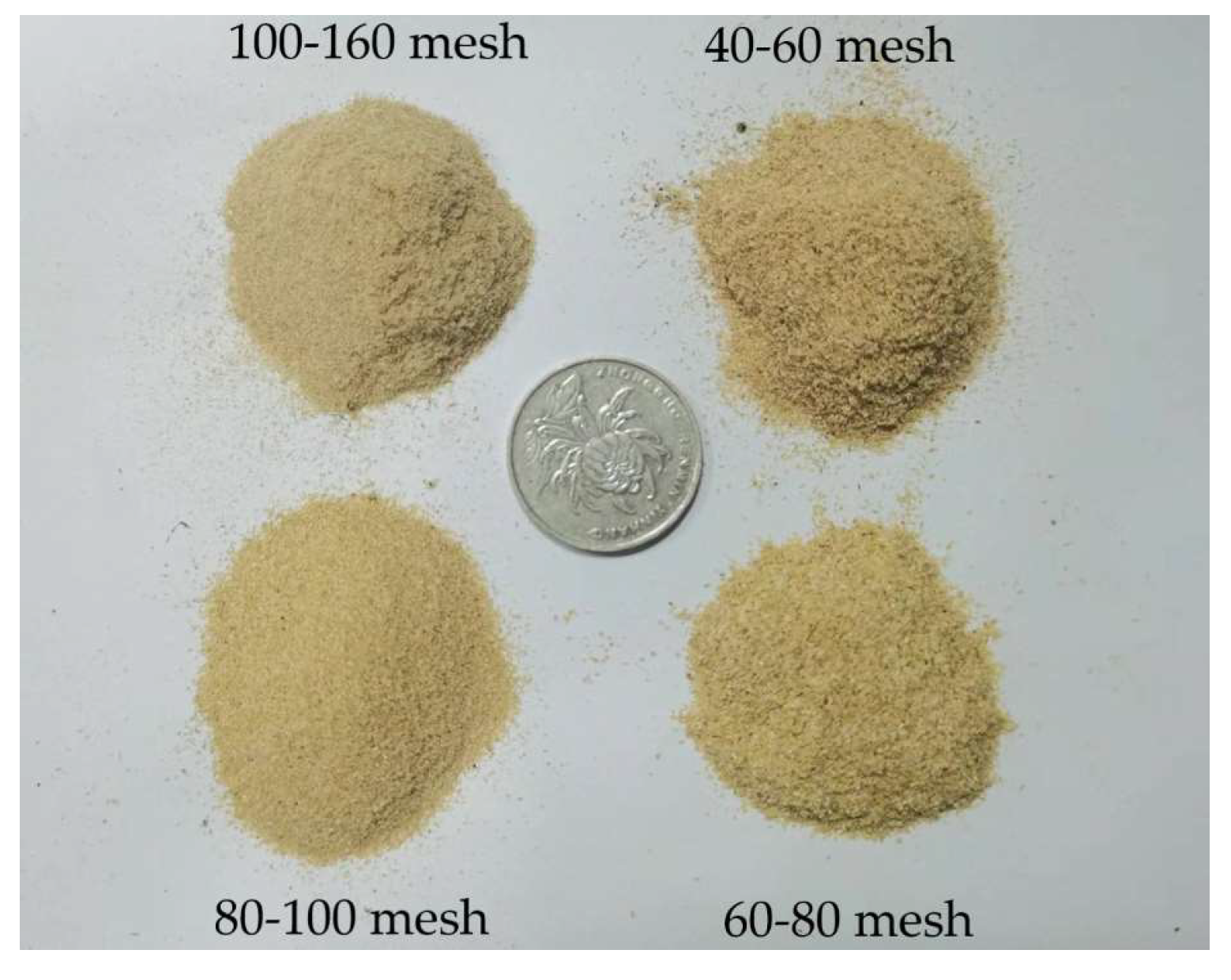
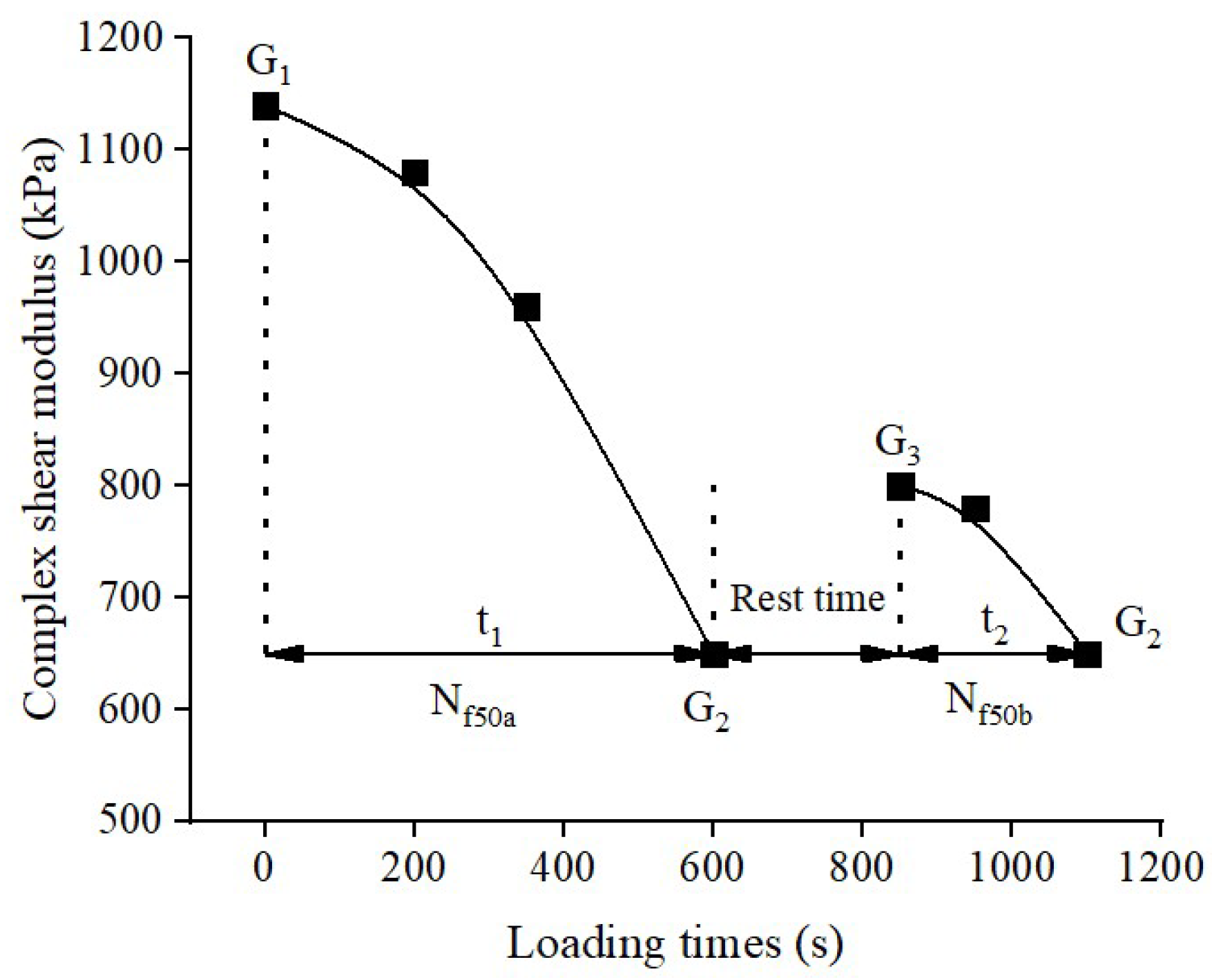
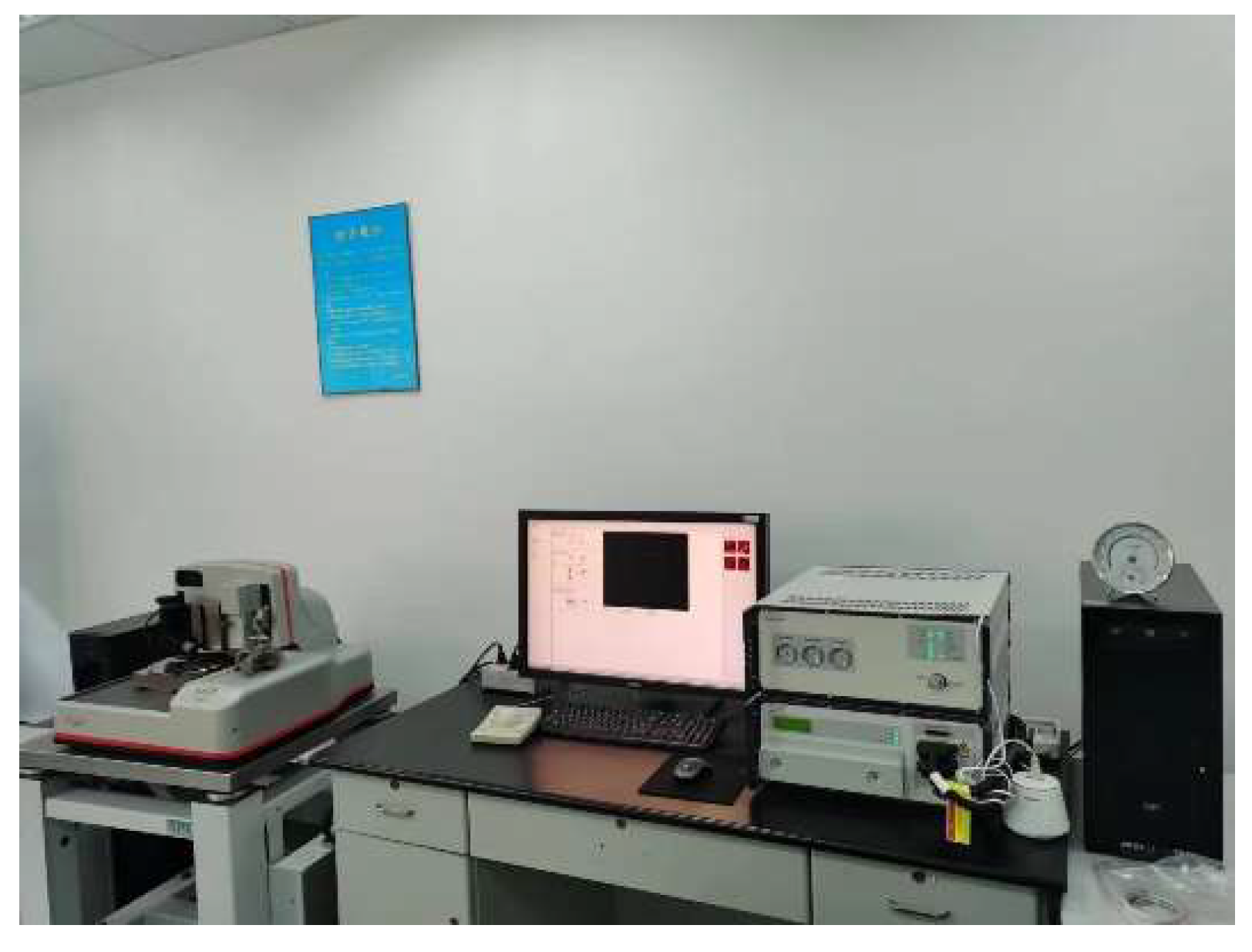
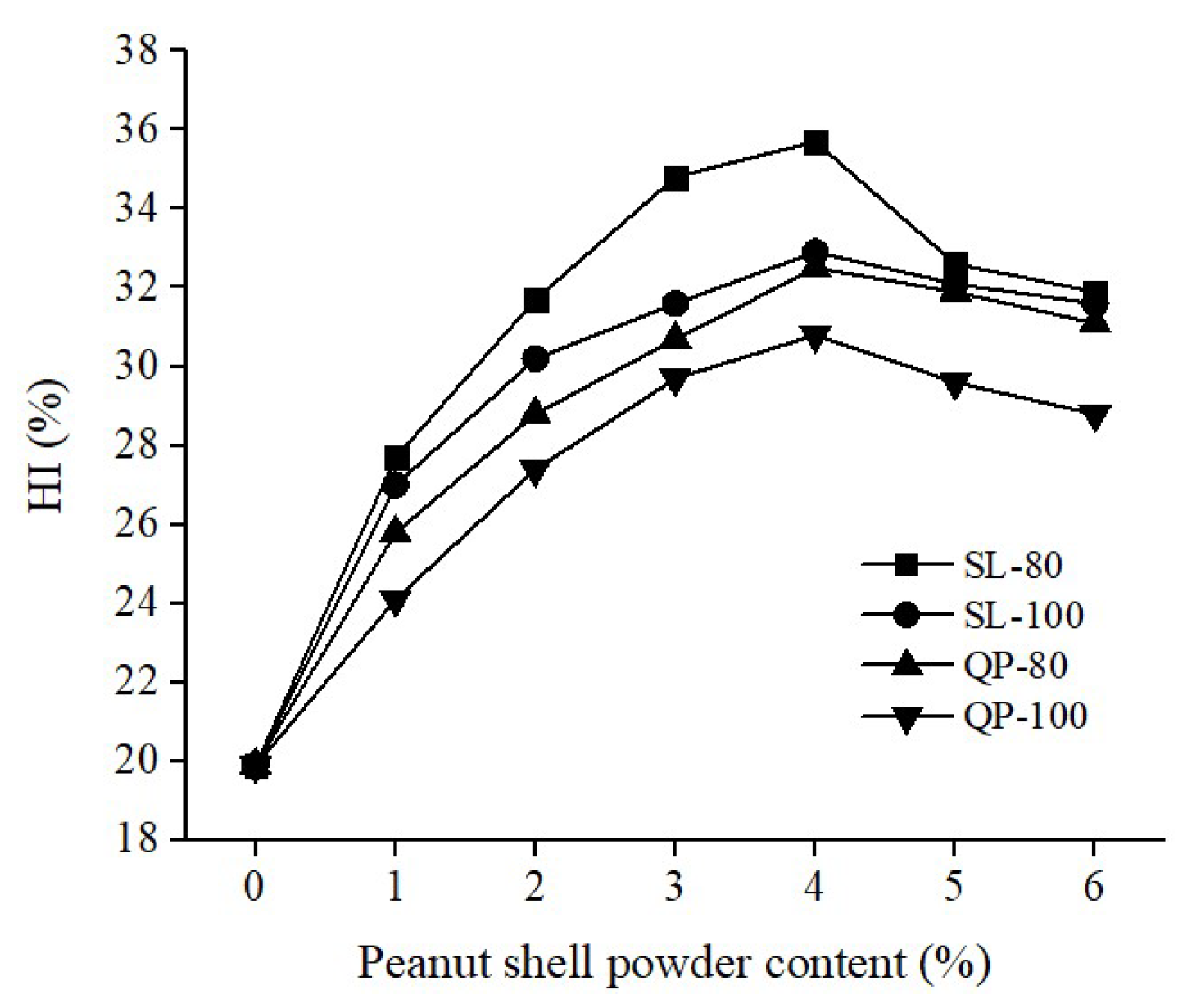
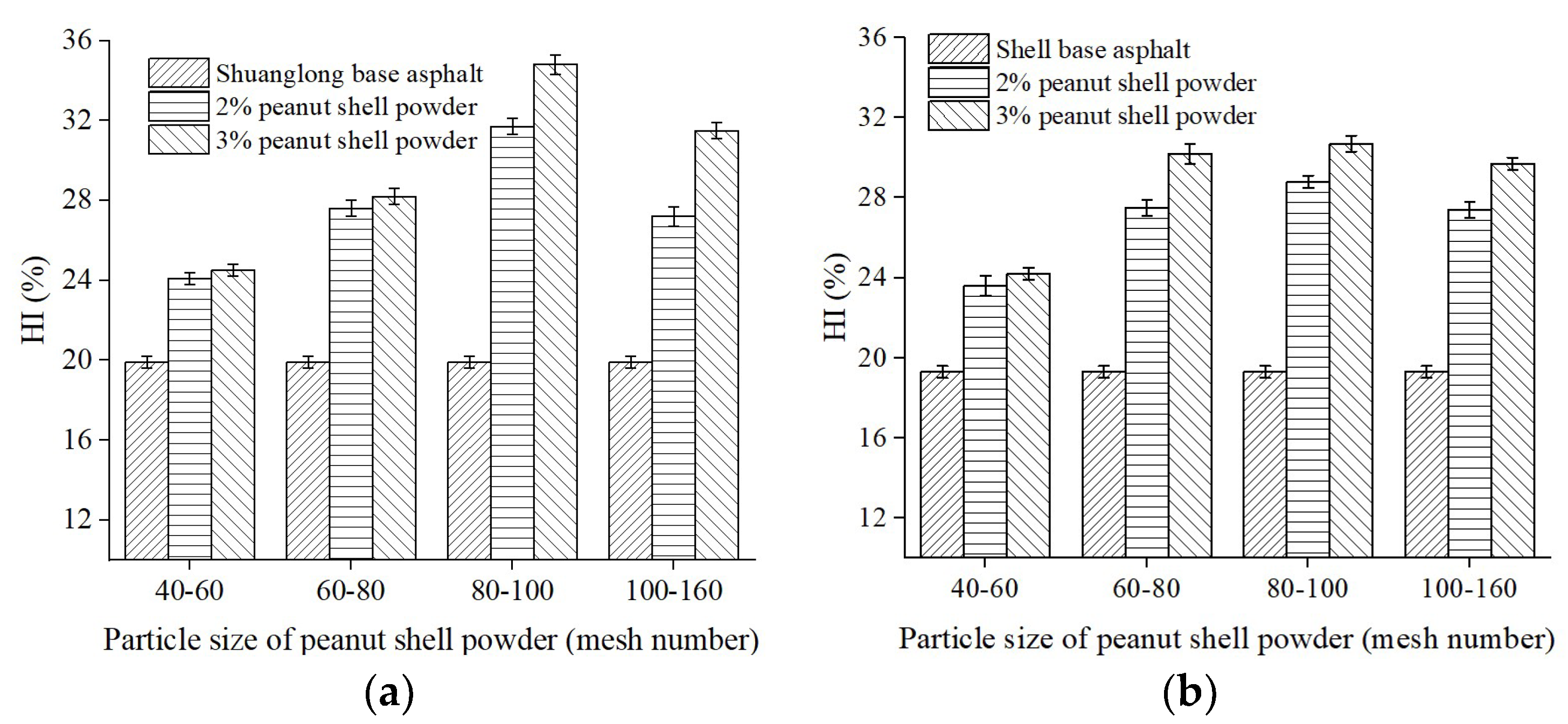
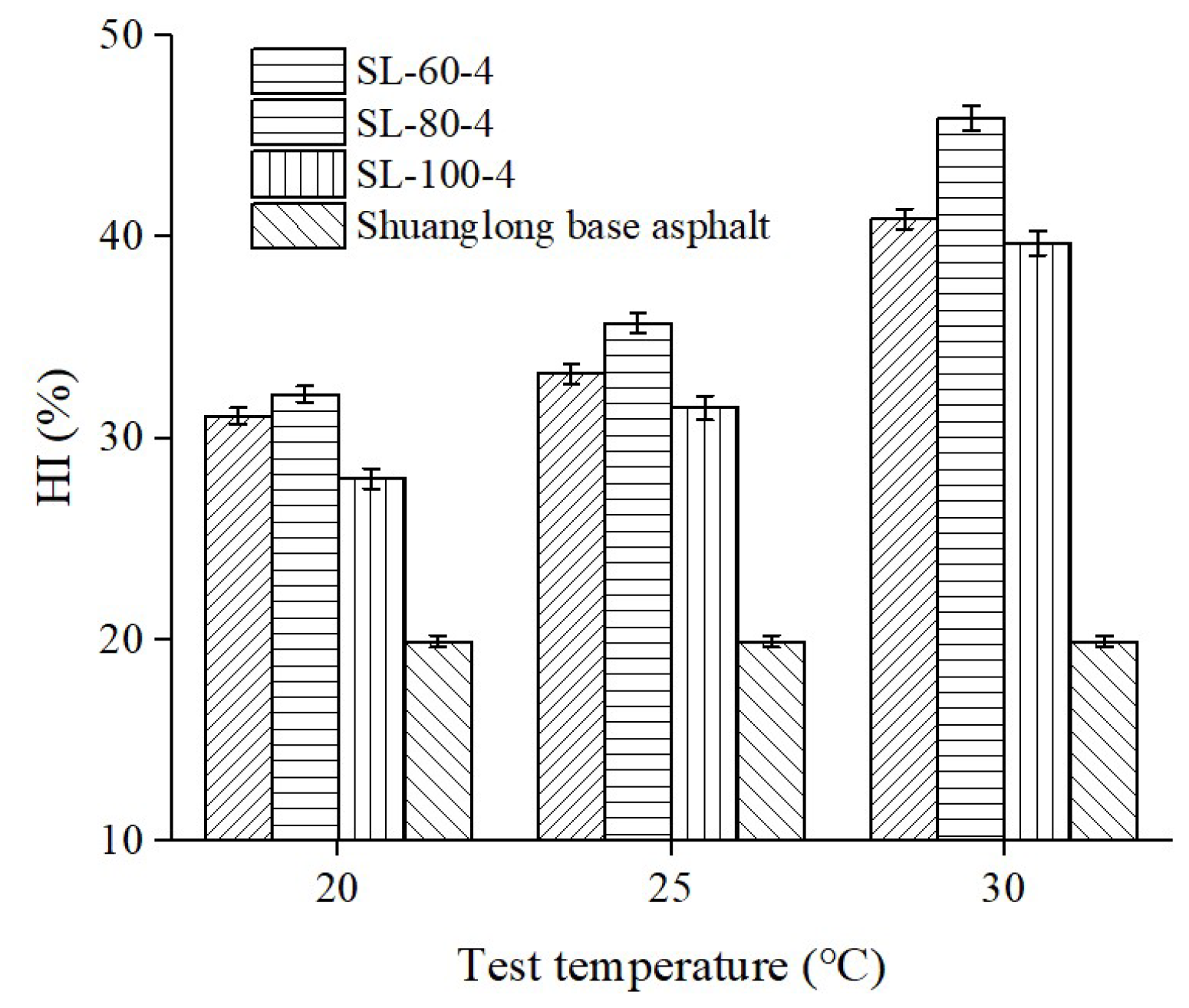

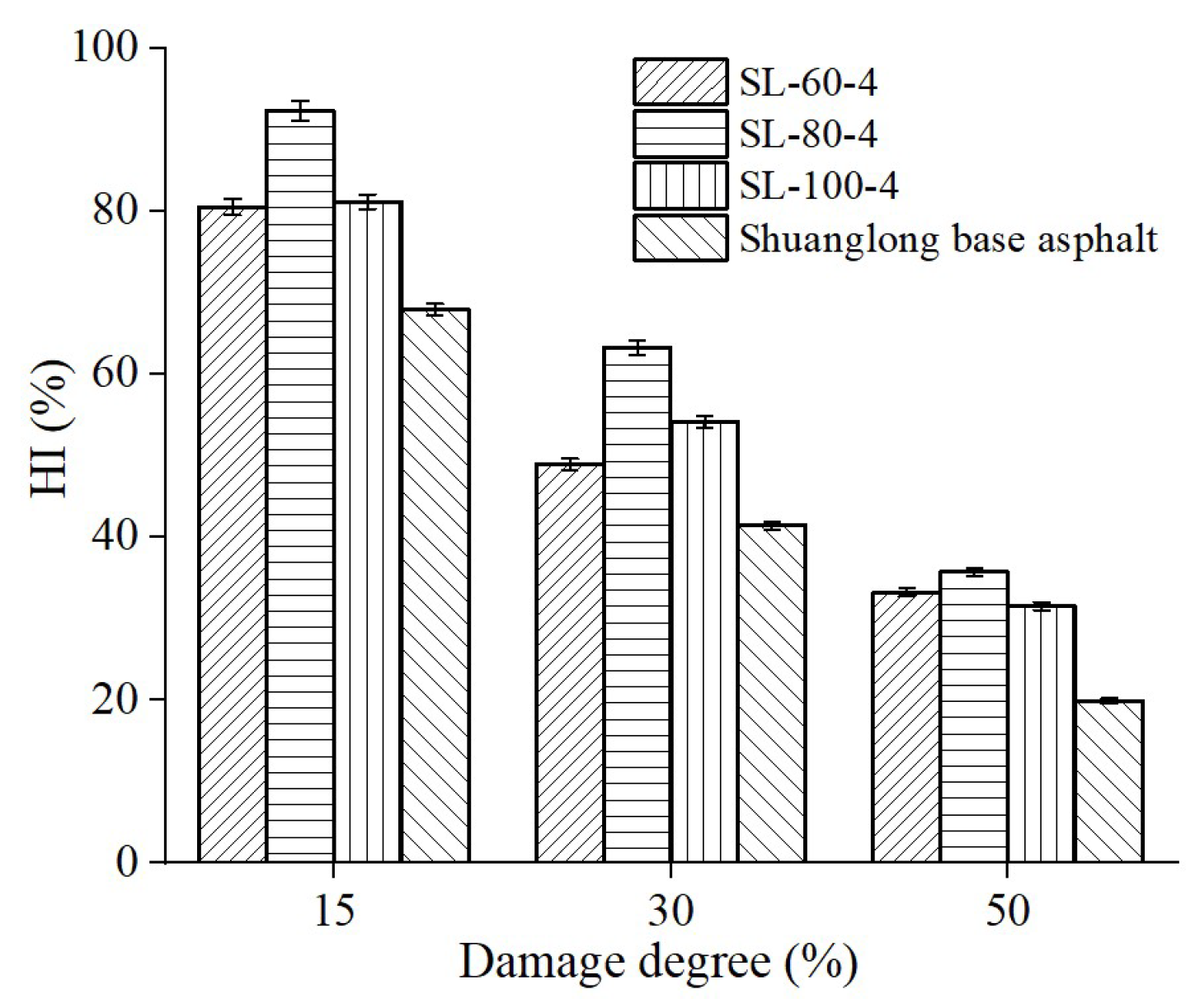

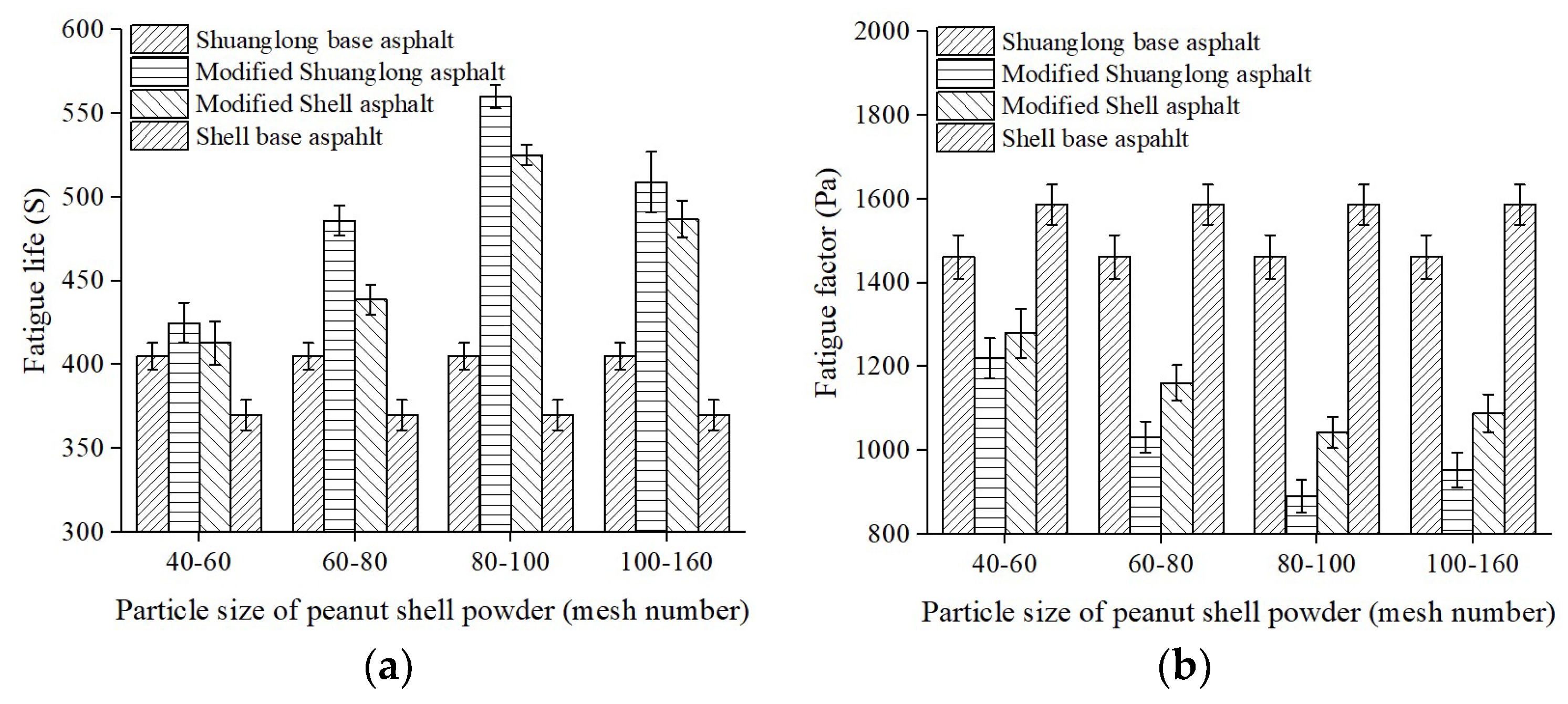
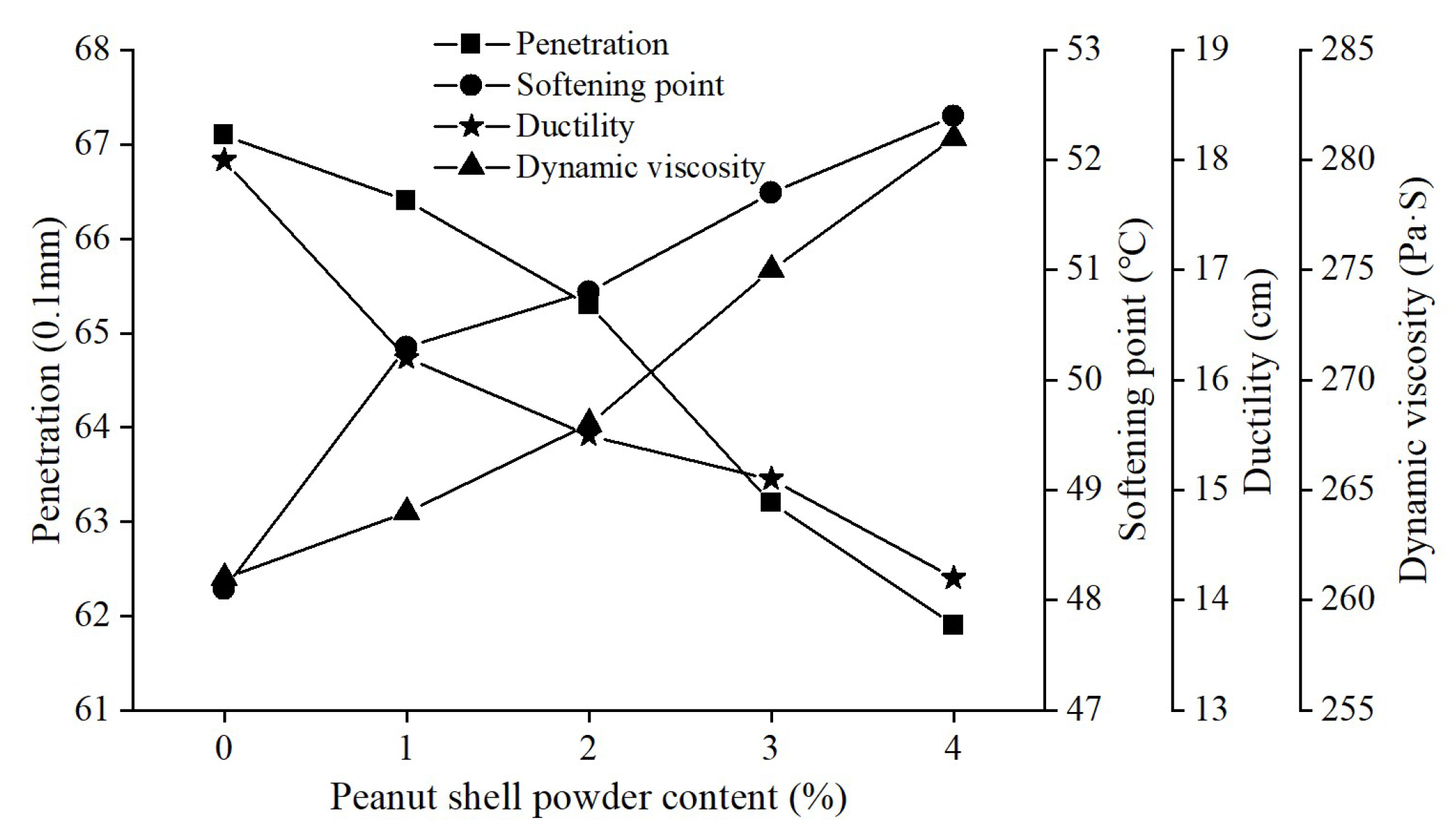
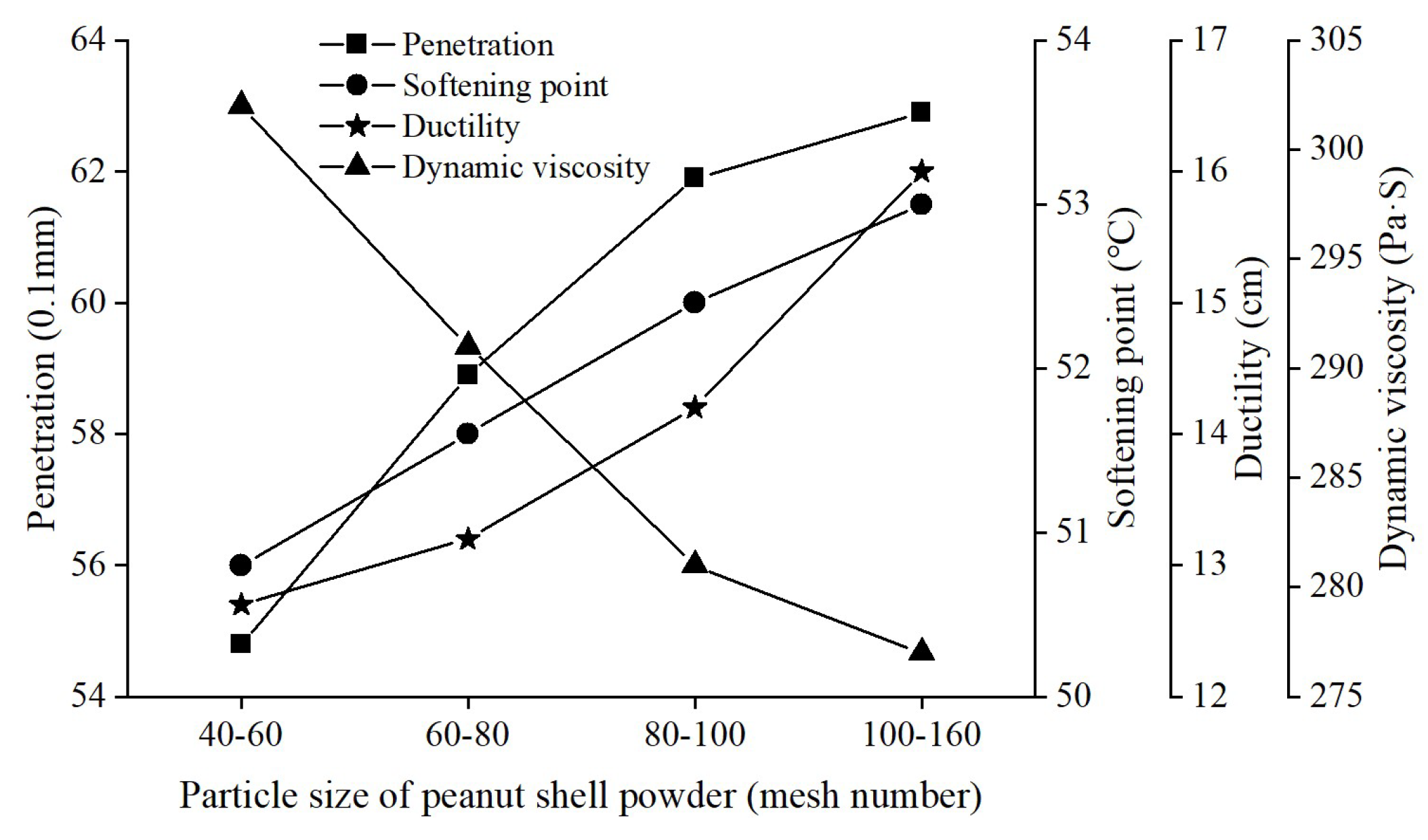
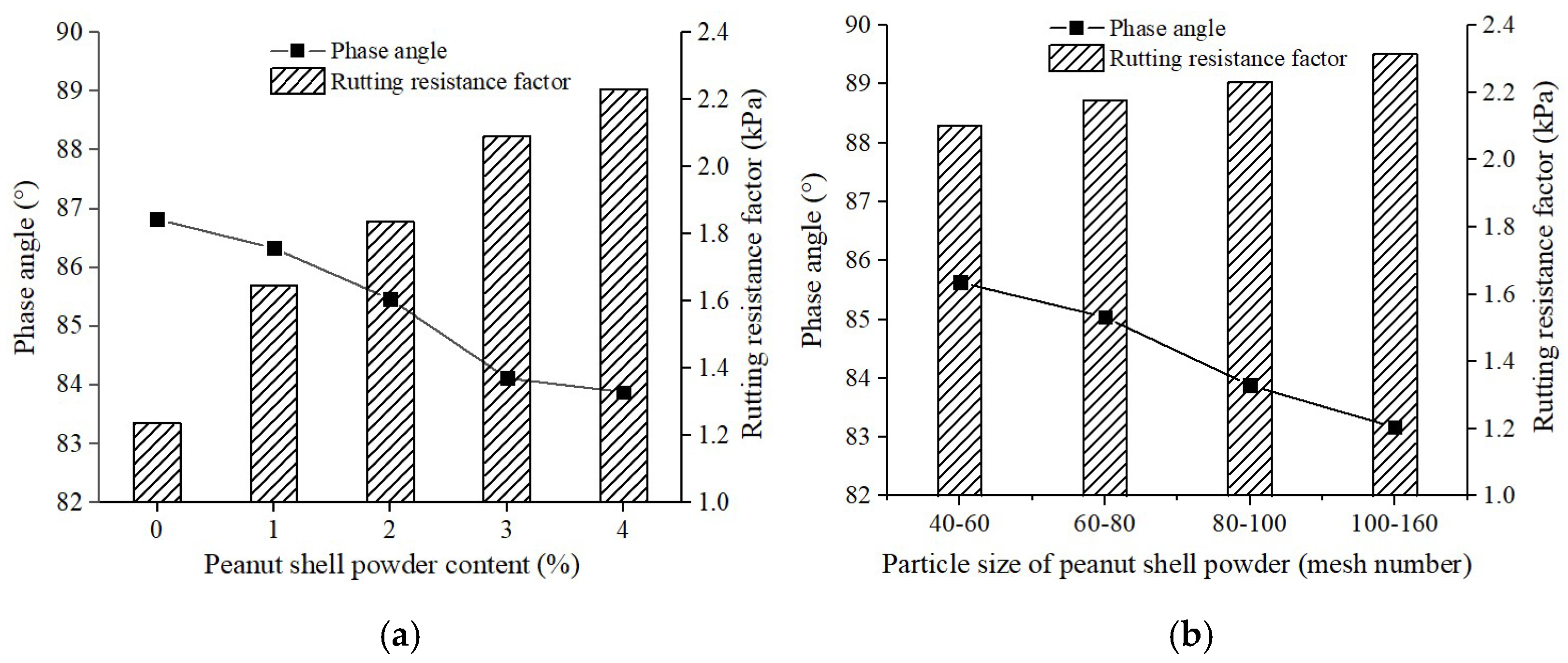
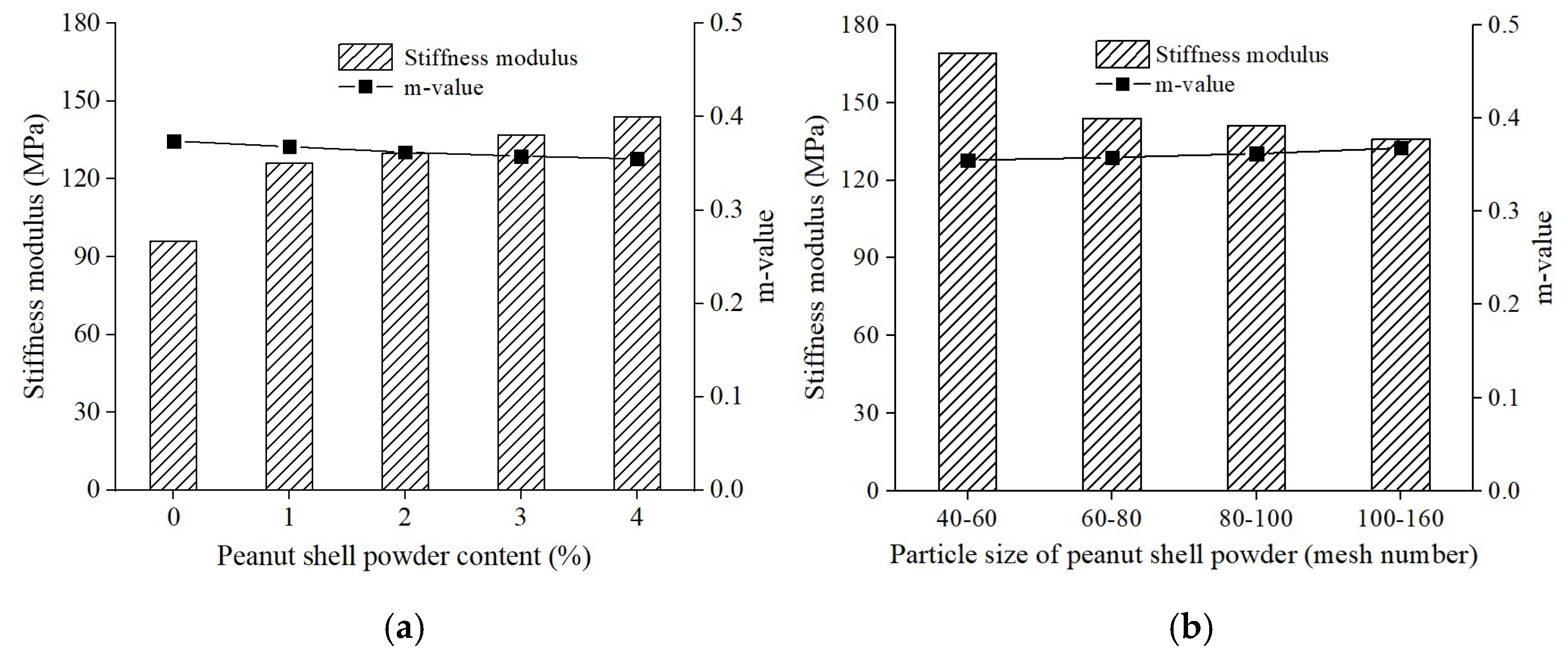

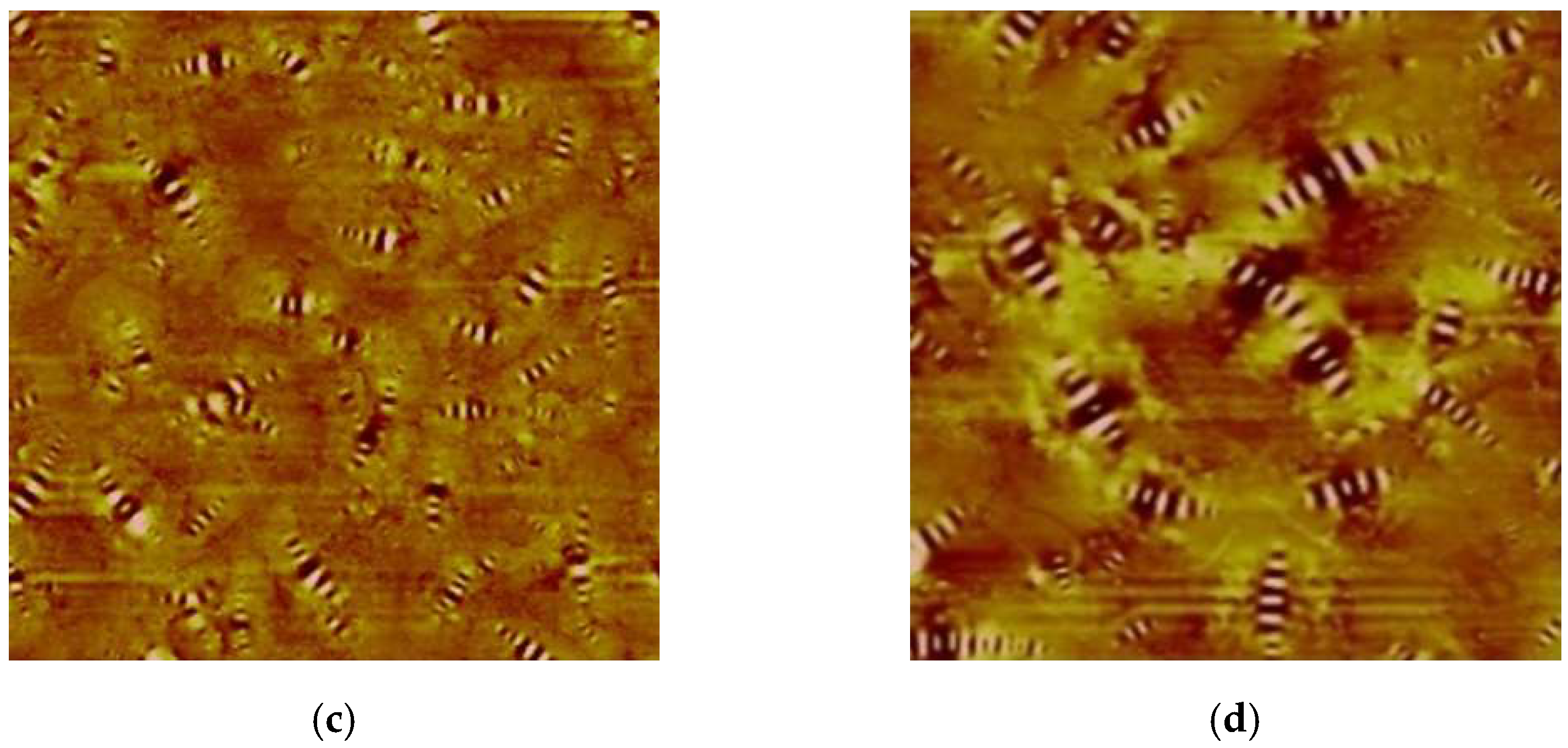

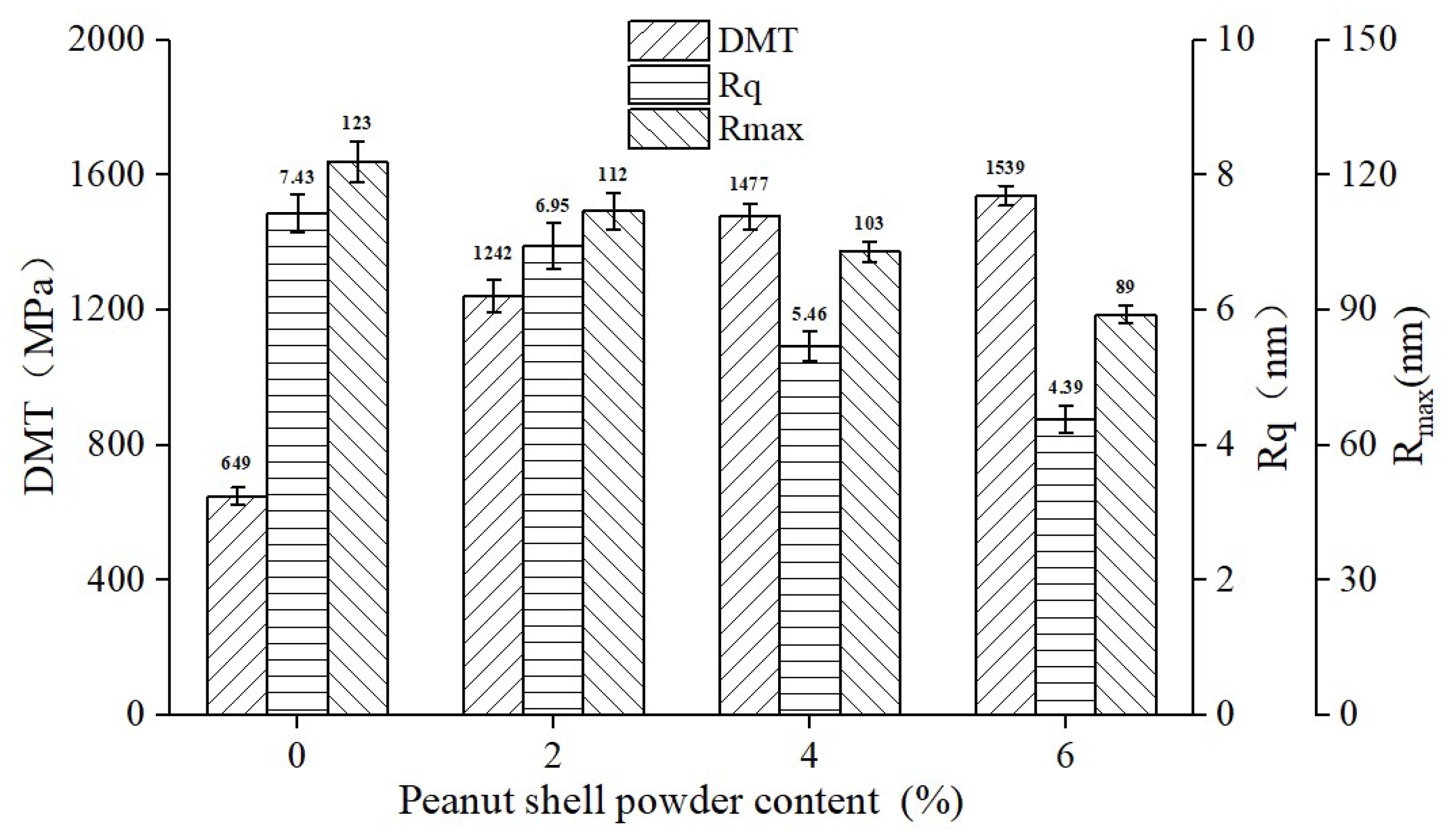
| Measurements | Actual Value |
|---|---|
| Density/(g/cm3) | 0.7 |
| Melting point/°C | 330 |
| Flash point/°C | 239.5 |
| Measurements | Shuanglong | Shell |
|---|---|---|
| Penetration (25 °C)/0.1 mm | 67.1 | 63.2 |
| Softening point/°C | 48.1 | 48.6 |
| Ductility (10 °C)/cm | 18.0 | 25.5 |
| Dynamic viscosity (60 °C)/Pa·S | 261 | 282 |
| Mass loss/% | 0.5 | 0.4 |
| Performance Grade | 64–22 | 64–22 |
| Content of Peanut Shell Powder/% | Particle Size of Peanut Shell Powder/Mesh | Shuanglong Base Asphalt | Shell Base Asphalt |
|---|---|---|---|
| 1 | 40–60 | SL-40-1 | QP-40-1 |
| 2 | 60–80 | SL-60-2 | QP-60-2 |
| 3 | 80–100 | SL-80-3 | QP-80-3 |
| 4 | 100–160 | SL-100-4 | QP-100-4 |
Disclaimer/Publisher’s Note: The statements, opinions and data contained in all publications are solely those of the individual author(s) and contributor(s) and not of MDPI and/or the editor(s). MDPI and/or the editor(s) disclaim responsibility for any injury to people or property resulting from any ideas, methods, instructions or products referred to in the content. |
© 2023 by the authors. Licensee MDPI, Basel, Switzerland. This article is an open access article distributed under the terms and conditions of the Creative Commons Attribution (CC BY) license (https://creativecommons.org/licenses/by/4.0/).
Share and Cite
Wang, B.; Shen, J.; Li, S.; Wang, W. Peanut Shell Powder as a Sustainable Modifier and Its Influence on Self-Healing Properties of Asphalt. Materials 2023, 16, 6618. https://doi.org/10.3390/ma16206618
Wang B, Shen J, Li S, Wang W. Peanut Shell Powder as a Sustainable Modifier and Its Influence on Self-Healing Properties of Asphalt. Materials. 2023; 16(20):6618. https://doi.org/10.3390/ma16206618
Chicago/Turabian StyleWang, Bo, Junan Shen, Shuang Li, and Wei Wang. 2023. "Peanut Shell Powder as a Sustainable Modifier and Its Influence on Self-Healing Properties of Asphalt" Materials 16, no. 20: 6618. https://doi.org/10.3390/ma16206618




